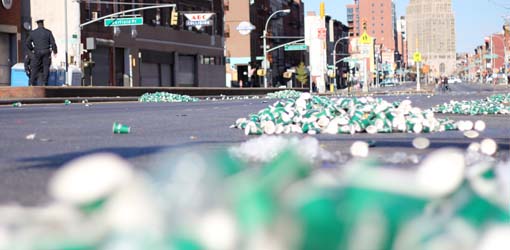The Race Behind the Race
Posted on December 2, 2010 | posted by:The carbon footprint of the 2010 ING New York City Marathon is overlooked by the personal achievements of its participants. The ecological impact of the marathon is overwhelming. How can such an event that highlights human biological efficiency overlook the inefficiency of its proceedings?
Auditing this year’s race yields disturbing results: 11 tons of trash collected, consisting of 62,370 gallons of water, 32,040 gallons of Gatorade, 2.3 million paper cups, 60,000 Power Bar Gel packets 60,000 heat sheets, 52,000 food bags, not to mention the countless articles of clothing stripped off throughout the day by runners and the 1200 vehicles needed to clean up the mess.
The marathon is celebrated annually throughout the city, and broadcasted nationally. So why doesn’t the city or its corporate sponsorship use the race to promote green-living? What steps are the parties involved taking toward the sustainability of such a community centered event?
Eco-friendly marathons are out there. ReSport, an organization established by the Council for Responsible Sport to certify races around the US, lists numerous points of intervention at traditional races. ING even embraces a few of these tips at other races it endorses around the country. The knowledge and technology to change is out there; the incentive is not.
What kind of leverage would it take to warrant change? Charities pulling the life-line on funding? The city granting event permits with more severe stipulations? Public volunteers opting not to clean up the mess? Or corporations cashing in on their newly acquired social conscious?
A more carbon neutral NYC Marathon could play out in a number of ways:
Runners transported to the starting line by MTA hybrid vehicles; ING providing bamboo running apparel that are donated after the race; the use of soy based marking inks; Asics establishing a sneaker recycling program; Gatorade providing corn-based recycled drinking cups; Poland Spring setting up water bubbling stations; farmers’ markets providing local produce throughout the course; virtual gift bags and up-cycled medals donated by local artists. Imagine the message New York City might send by demonstrating its commitment to sustainability?
We run to connect to ourselves, our fellow man, and our planet. I would like to see the marathon set the precedent of responsibility for large scale sporting events around the world. Marathons are long and demand a runner’s endurance, sacrifice and foresight to be successful, and their ecological impact demands the same.
